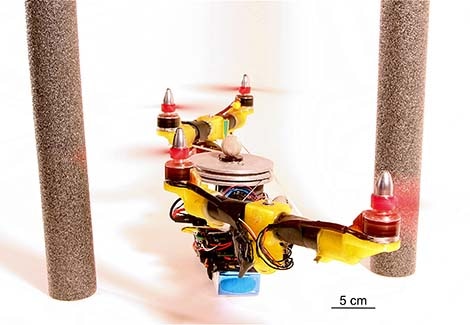Jun 1 2018
For the first time in the world, scientists from the Étienne Jules Marey Institute of Movement Sciences (CNRS/Aix-Marseille Université) have drawn inspiration from birds to develop an aerial robot with the ability to change its profile during flight. It can reorient its arms, which are fitted with propellers that enable it to fly similar to a helicopter, to reduce its wingspan and navigate through cramped spaces.
 The Quad-Morphing robot. (Image credit: Valentin Rivière and Stéphane Viollet, Étienne Jules Marey Institute of Movement Sciences (CNRS/Aix-Marseille Université))
The Quad-Morphing robot. (Image credit: Valentin Rivière and Stéphane Viollet, Étienne Jules Marey Institute of Movement Sciences (CNRS/Aix-Marseille Université))
The study of the researchers is the subject of an article published on May 30th, 2018, in Soft Robotics. It opens the door for an innovative generation of large robots with the ability to move through narrow passages, rendering them perfect for exploration and search and rescue missions.
Winged insects and birds have the exceptional capacity to maneuver quickly to clear obstacles during flight. Extreme agility such as this is required for navigation through tight spaces and crowded environments, such as forests. Miniature flying machines have already been developed, with the ability to pitch, roll, or change their flight attitude to go through small apertures. However, another approach is illustrated by birds, which is equally effective for flying through bottlenecks. They have the ability to quickly fold their wings at the time of high-speed flight, minimizing their imposing span, to easily negotiate the difficult paths before them.1
Deployment of aerial robots in cramped and chaotic areas for mapping, exploratory, or search and rescue operations will turn out to be increasingly normal. They should possess the ability to circumnavigate several obstacles and navigate through pretty cramped passages to complete their missions. Hence, scientists from the Étienne Jules Marey Institute of Movement Sciences (CNRS/Aix-Marseille Université) have developed a flying robot with the ability to reduce its wingspan during flight to travel through a small opening, without the need for intensive steering that would take up too much energy and mandate a robotic platform with a low inertia (small and light robot).2
Named Quad-Morphing, the innovative robot is equipped with two rotating arms each fitted with two propellers for a flight similar to a helicopter. A framework of rigid and elastic wires enables the robot to alter the orientation of its arms during flight such that they are either parallel or perpendicular to its central axis. It uses the parallel position, in which its wingspan is halved, to navigate through a narrow stretch and then shifts back to the perpendicular position to stabilize its flight; all this is done during a flight of 9 km/h, which is quite fast for an aerial robot.
Currently, the agility of the robot is governed by the precision of the Quad-Morphing autopilot mechanism. The arm reorientation is activated by the autopilot when the robot gets closer to a cramped passage, as determined by a 3D localization system employed at the institute.3 The scientists have also fitted the robot with a miniature camera with the ability to capture 120 pictures within a second. In the future, this will enable Quad-Morphing to independently evaluate the size of the gap in front of it and fold its wings suitably if necessary. Flight testing with the new camera has been proposed to start this month.
Notes
- Such remarkable behavior has been observed in goshawks and budgerigars flying at speeds of more than 14 km/h.
- Flying robots have a typical transversal speed of 4–5 km/h in indoor conditions.
- The studies were performed at the AVM flying machine arena, constructed with financial support from the French Equipex Robotex program. The arena has 17 cameras for recording movement.